
Butomus umbellatus is a Eurasian plant species in the family Butomaceae. It is the only species in the family. Common names include flowering rush or grass rush. Introduced into North America as an ornamental plant it has now become a serious invasive weed in the Great Lakes area and in parts of the Pacific Northwest. In Israel, one of its native countries, it is an endangered species due to the habitat loss. It can also be found in Great Britain locally, for example at the Caldicot and Wentloog Levels The plant is a rhizomatous, hairless, perennial aquatic plant. Its name is derived from Greek bous, meaning "cow", "ox" etc. and tome, a cut, which refers to the plant's swordlike leaves.

Petasites frigidus, the Arctic sweet coltsfoot or Arctic butterbur, is a species of flowering plant in the family Asteraceae. It is native to Arctic to cool temperate regions of the Northern Hemisphere in northern Europe, northern Asia and northern North America.

Arabis, or rockcress, is a genus of flowering plants, within the family Brassicaceae.
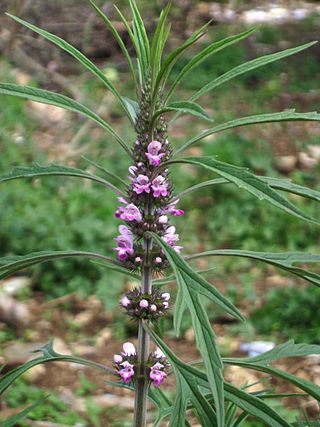
Leonurus sibiricus, commonly called honeyweed or Siberian motherwort, is an herbaceous plant species native to China, Mongolia, and Siberia. It has verticillaster inflorescence. It is naturalized in many other parts of the world, including South, Central and North Americas.

Heteranthera limosa is an annual flowering plant in the water hyacinth family known by the common names ducksalad and blue mudplantain. It grows in shallow water or on mud. It is considered a threatened species in parts of the central United States, and an invasive species weed in California, where it is a nuisance in rice paddies. It is also occasional in Florida waterways.

Empetrum nigrum, crowberry, black crowberry, or, in western Alaska, blackberry, is a flowering plant species in the heather family Ericaceae with a near circumboreal distribution in the Northern Hemisphere. It is usually dioecious, but there is a bisexual tetraploid subspecies, Empetrum nigrum subsp. hermaphroditum, which occurs in more northerly locations and at higher altitude.

Trillium recurvatum, the prairie trillium, toadshade, or bloody butcher, is a species of perennial herbaceous flowering plant in the family Melanthiaceae. It is native to parts of central and eastern United States, where it is found from Iowa south to Texas and east to North Carolina and Pennsylvania. It grows in mesic forests and savannas, often in calcareous soils. It is also known as bloody noses, red trillium, prairie wake-robin, purple trillium, and reflexed trillium, in reference to its reflexed sepals.

Boechera breweri is a species of flowering plant in the family Brassicaceae known by the common name Brewer's rockcress.
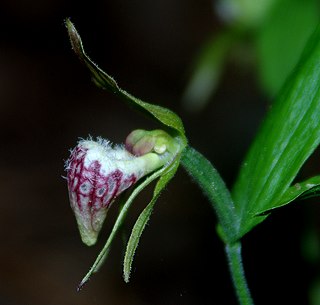
Cypripedium arietinum, the ram's head lady's slipper, is a rare orchid that grows in lightly shaded areas with calcareous soils. It is characteristic of the alvars around the Great Lakes in North America, as well as in New England. In Canada, it is found from Quebec to Saskatchewan, plus an isolated population in Nova Scotia, where it grows on gypsum based soils, 330 km away from the nearest population in Maine.
Boechera tularensis, common name Tulare rockcress, is a plant species endemic to California. It has been reported from Inyo, Mono, Tulare, Fresno, Madera, El Dorado and Mariposa Counties. It grows on rocky slopes in subalpine habitats at elevations of 2400–3200 m.
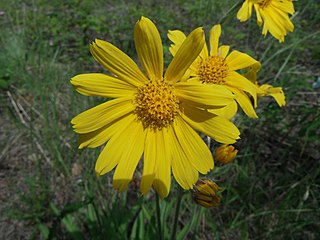
Arnica lonchophylla is a species of flowering plant in family Asteraceae. The common names for this species includes longleaf arnica, northern arnica, and spear-leaved arnica. It has daisy-like yellow flowers that are 2.5 to 5 cm across with a yellow center disks.

Euphorbia missurica, commonly called prairie sandmat, or Missouri spurge, is a species of flowering plant in the spurge family (Euphorbiaceae). It is native to North America, where it is found primarily in area of the Great Plains. Its natural habitat is in dry, often calcareous areas, including glades, bluffs, and open woodlands.

Boechera dentata, commonly called Short's rockcress, is a species of flowering plant in the mustard family (Brassicaceae). It is native to the eastern North America, where it is found in Canada and the United States. In the United States, its range is primarily centered in the Midwest, and in Canada it is only known from Ontario. Its natural habitat is in nutrient-rich alluvial forests and loamy bluffs, often on calcareous substrate.
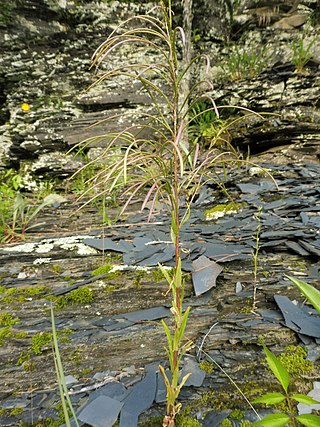
Boechera missouriensis, commonly called Missouri rockcress, is a species of flowering plant in the mustard family (Brassicaceae). It is native to the eastern United States, where it has a highly fragmented range localized in the Northeast, the Upper Midwest, the Interior Highlands, and the Southeast. Its natural habitat is typically on rocky or sandy woodlands and bluffs, in areas of acidic soil. It is generally uncommon throughout most of its range, with exception for the Interior Highlands region.

Bartonia virginica is species of flowering plant in Gentianaceae. It is the commonly called yellow screwstem or yellow bartonia and it is an annual species with small pale green to yellow flowers.
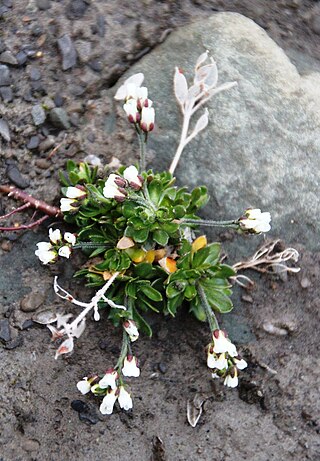
Draba norvegica is a species of flowering plant in the mustard family (Brassicaceae) know by the common names Norwegian draba and Norwegian whitlow grass.
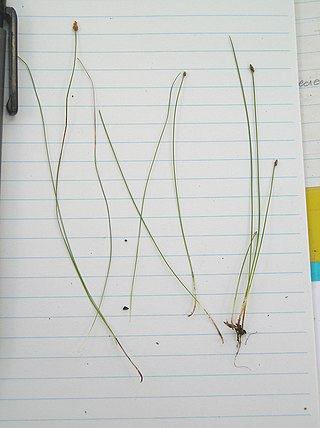
Eleocharis nitida is a species of flowering plant commonly called neat spikerush, it is a member of the sedge family Cyperaceae.

Juncus marginatus is a species of flowering plant, it is a type of rush with the common names of margined rush and grass-leaf rush.

Nymphaea tetragona is an aquatic perennial, species of flowering plant commonly called pygmy waterlily and small white water lily, belonging to the family Nymphaeaceae.

Boechera patens, commonly called spreading rockcress, is a species of flowering plant in the mustard family (Brassicaceae). It is a short-lived biennial forb native to North America. Its natural habitat is xeric soil, often on calcareous substrates. It produces white flowers in the spring.



















